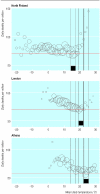Heat related mortality in warm and cold regions of Europe: observational study
- PMID: 10987770
- PMCID: PMC27480
- DOI: 10.1136/bmj.321.7262.670
Heat related mortality in warm and cold regions of Europe: observational study
Abstract
Objectives: To assess heat related mortalities in relation to climate within Europe.
Design: Observational population study.
Setting: North Finland, south Finland, Baden-Württemberg, Netherlands, London, north Italy, and Athens.
Subjects: People aged 65-74.
Main outcome measures: Mortalities at temperatures above, below, and within each region's temperature band of minimum mortality.
Results: Mortality was lowest at 14.3-17.3 degrees C in north Finland but at 22.7-25.7 degrees C in Athens. Overall the 3 degrees C minimum mortality temperature bands were significantly higher in regions with higher than lower mean summer temperatures (P=0.027). This was not due to regional differences in wind speeds, humidity, or rain. As a result, regions with hot summers did not have significantly higher annual heat related mortality per million population than cold regions at temperatures above these bands. Mean annual heat related mortalities were 304 (95% confidence interval 126 to 482) in North Finland, 445 (59 to 831) in Athens, and 40 (13 to 68) in London. Cold related mortalities were 2457 (1130 to 3786), 2533 (965 to 4101), and 3129 (2319 to 3939) respectively.
Conclusions: Populations in Europe have adjusted successfully to mean summer temperatures ranging from 13.5 degrees C to 24.1 degrees C, and can be expected to adjust to global warming predicted for the next half century with little sustained increase in heat related mortality. Active measures to accelerate adjustment to hot weather could minimise temporary rises in heat related mortality, and measures to maintain protection against cold in winter could permit substantial reductions in overall mortality as temperatures rise.
Figures

Comment in
-
Saving lives during extreme weather in summer.BMJ. 2000 Sep 16;321(7262):650-1. doi: 10.1136/bmj.321.7262.650. BMJ. 2000. PMID: 10987751 Free PMC article. No abstract available.
References
-
- Keatinge WR, Donaldson GC, Bucher K, Cordioli E, Dardanoni L, Jendritzky G, et al. Cold exposure and winter mortality from ischaemic heart disease, cerebrovascular disease, respiratory disease, and all causes in warm and cold regions of Europe. Lancet. 1997;349:1341–1346. - PubMed
-
- Keatinge WR, Coleshaw SRK, Easton JC, Cotter F, Mattock MB, Chelliah R. Increased platelet and red cell counts, blood viscosity and plasma cholesterol level during heat stress, and mortality from coronary and cerebral thromboses. Am J Med. 1986;81:795–800. - PubMed
-
- Falcao JM, Valente P. Cerebrovascular diseases in Portugal: some epidemiological aspects. Acta Med Port. 1977;10:537–542. - PubMed
-
- Katsouyanni K, Trichopoulos D, Zabitsanos X, Touloumi G. The 1987 Athens heatwave. Lancet. 1988;ii:575. - PubMed
-
- Kunst AE, Looman CW, Mackenbach JP. Outdoor air temperature and mortality in the Netherlands. Am J Epidemiol. 1993;137:331–341. - PubMed
Publication types
MeSH terms
LinkOut - more resources
Full Text Sources
Research Materials
